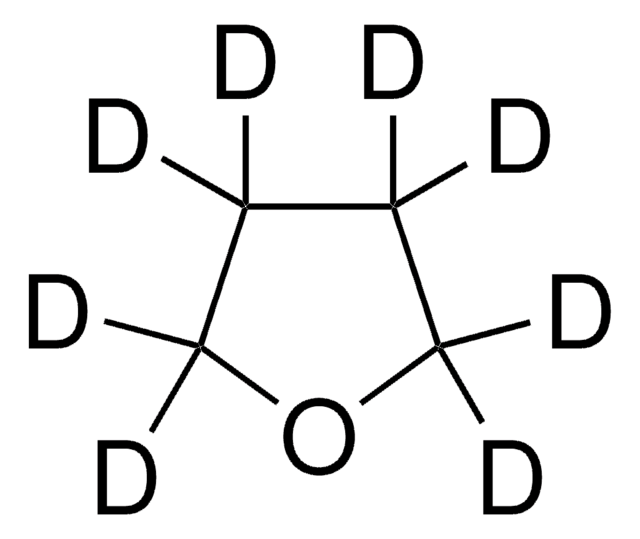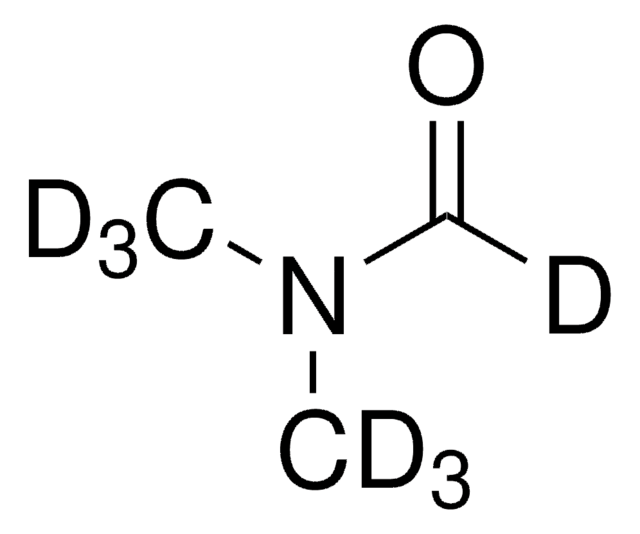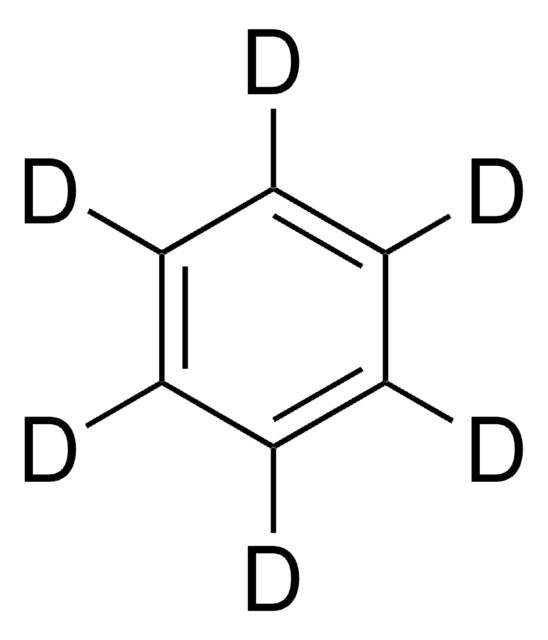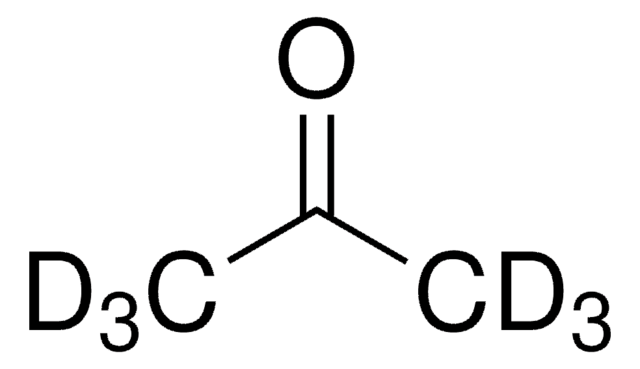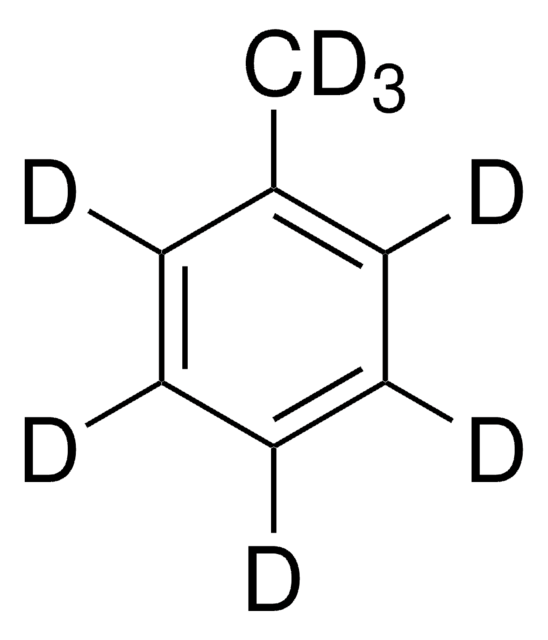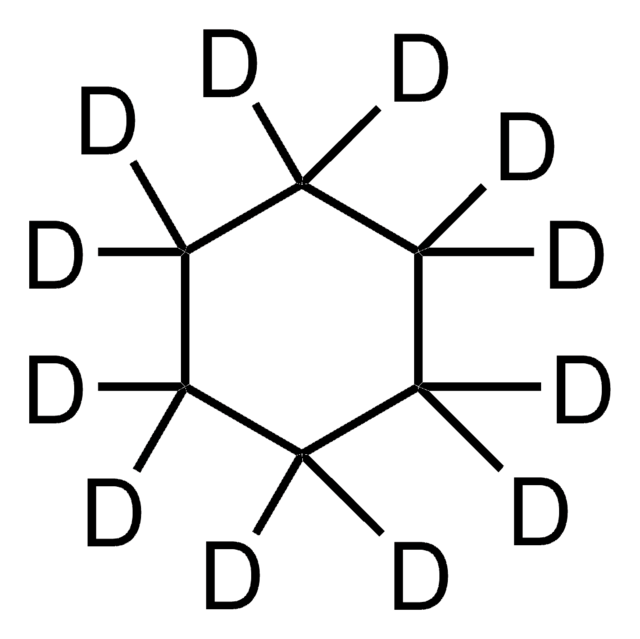Kluczowe dokumenty
437727
Tetrahydrofuran-d8
≥99.5 atom % D, contains 0.03 % (v/v) TMS
Synonim(y):
THF-d8, Deuterated tetrahydrofuran, Octadeuterotetrahydrofuran
About This Item
Polecane produkty
czystość izotopowa
≥99.5 atom % D
Poziom jakości
Próba
≥99% (CP)
Formularz
liquid
zawiera
0.03 % (v/v) TMS
metody
NMR: suitable
zanieczyszczenia
≤0.03% water
water
współczynnik refrakcji
n20/D 1.403 (lit.)
bp
65-66 °C (lit.)
mp
−106 °C (lit.)
gęstość
0.985 g/mL at 25 °C (lit.)
przesunięcie masy
M+8
temp. przechowywania
2-8°C
ciąg SMILES
[2H]C1([2H])OC([2H])([2H])C([2H])([2H])C1([2H])[2H]
InChI
1S/C4H8O/c1-2-4-5-3-1/h1-4H2/i1D2,2D2,3D2,4D2
Klucz InChI
WYURNTSHIVDZCO-SVYQBANQSA-N
Szukasz podobnych produktów? Odwiedź Przewodnik dotyczący porównywania produktów
Opis ogólny
Zastosowanie
- Experimental and Theoretical Study of CO2 Insertion into Ruthenium Hydride Complexes.: This research provides insights into the mechanistic pathways for CO2 reactivity with ruthenium hydride complexes, potentially relevant for catalytic applications including transformations involving Tetrahydrofuran-d₈ (Ramakrishnan et al., 2016).
- Syntheses, structures, and NMR chemical shifts of a family of trimethyltin alkoxide, amide, halide and cyclopentadienyl compounds.: Details the synthesis and structural characterization of trimethyltin compounds, useful for understanding the coordination chemistry that may involve Tetrahydrofuran-d₈ as a solvent or structural analogue (Lichtscheidl et al., 2015).
- NMR studies of coupled low- and high-barrier hydrogen bonds in pyridoxal-5′-phosphate model systems in polar solution.: Discusses the application of NMR spectroscopy in studying hydrogen bonding interactions, where Tetrahydrofuran-d₈ could be utilized as a deuterated solvent for enhanced spectral clarity (Sharif et al., 2007).
- Stable hydrocarbon diradical, an analogue of trimethylenemethane.: Investigates stable hydrocarbon diradicals, where Tetrahydrofuran-d₈ may be used as part of the experimental setup to stabilize reactive intermediates or as a solvent to study radical stability (Rajca et al., 2005).
Polecane produkty
Hasło ostrzegawcze
Danger
Zwroty wskazujące rodzaj zagrożenia
Zwroty wskazujące środki ostrożności
Klasyfikacja zagrożeń
Acute Tox. 4 Oral - Carc. 2 - Eye Irrit. 2 - Flam. Liq. 2 - STOT SE 3
Organy docelowe
Central nervous system, Respiratory system
Zagrożenia dodatkowe
Kod klasy składowania
3 - Flammable liquids
Klasa zagrożenia wodnego (WGK)
WGK 1
Temperatura zapłonu (°F)
1.4 °F - closed cup
Temperatura zapłonu (°C)
-17 °C - closed cup
Wybierz jedną z najnowszych wersji:
Masz już ten produkt?
Dokumenty związane z niedawno zakupionymi produktami zostały zamieszczone w Bibliotece dokumentów.
Klienci oglądali również te produkty
Protokoły
Introduction to PAGE. Learn about SDS-PAGE background and protocol for the separation of proteins based on size in a poly-acrylamide gel.
Nasz zespół naukowców ma doświadczenie we wszystkich obszarach badań, w tym w naukach przyrodniczych, materiałoznawstwie, syntezie chemicznej, chromatografii, analityce i wielu innych dziedzinach.
Skontaktuj się z zespołem ds. pomocy technicznej
